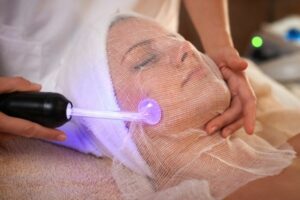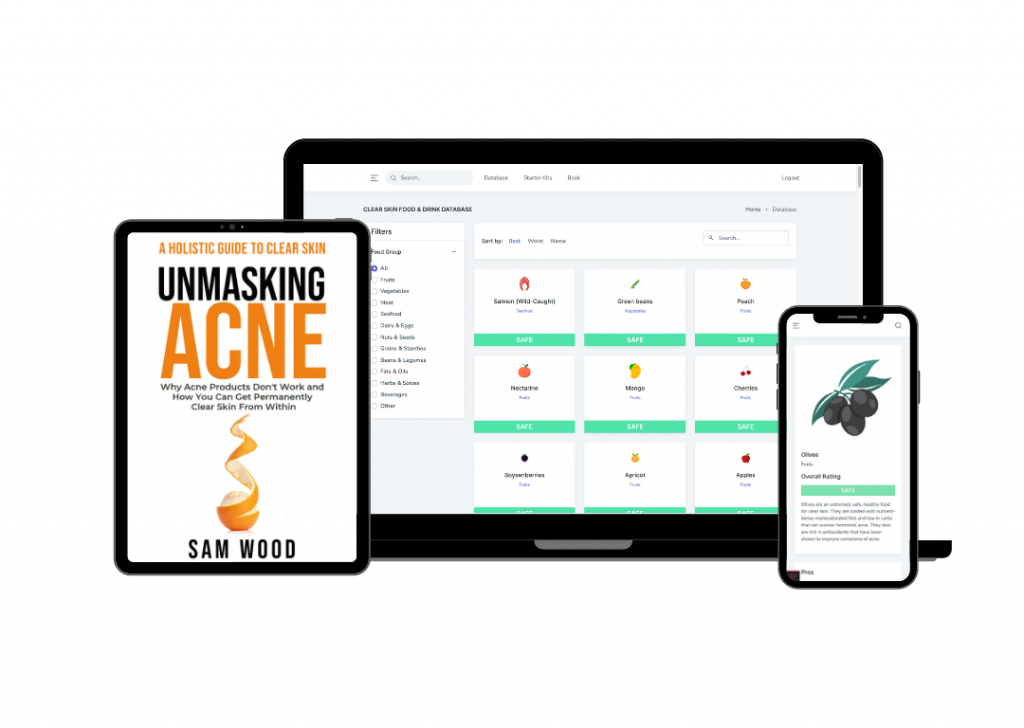Facials are supposed to be soothing and relaxing. However, can that also be said about a treatment that involves the usage of electrical currents?
Known as a high-frequency facial, this intimidating-sounding treatment is anything but.
From thorough facial rejuvenation to treating complex and stubborn conditions such as acne, here’s everything you need to know about the high-frequency facial and the benefits it offers for the skin:
What is a High-Frequency Facial?
A high-frequency facial is a professional treatment that consists of using a machine that works with high-frequency electrodes made out of thin glass that produce healing electrical light energy.
The electrodes come in different shapes and sizes to cover areas of the face, body, and scalp and can be adjusted into the main unit, depending on the area that’s being treated.
Once inserted into the main unit, the electrodes emit a harmless electrical current that ignites inert gas within the electrode, creating electrical light energy.
This current stimulates the skin with a gentle warming sensation while producing ozone formation.
Ozone is a purifying gas with antibacterial properties that helps kill off potentially pathogenic bacteria on the skin.
The gas also has a visible, temporary tightening effect, leaving the skin rejuvenated while reducing the appearance of redness and inflammation.
It also has a visible lifting effect and reduces inflammation and puffiness.
What Does a High-Frequency Facial Do To The Skin?
A high-frequency facial is excellent for skin rejuvenation as the treatment focuses on infusing oxygen through ozone formation into the skin and increasing cell metabolism.
Increased cell metabolism means that the skin cells, which are the primary construction of the outermost skin layer, will start to behave in a “younger” manner once infused with oxygen.
This means the cells will regenerate faster and become healthier, just like when the skin was younger.
It also means that the skin will regenerate quicker and easier, leading to a clearer, healthier complexion that’s even, toned, and radiant.
Benefits of a High-Frequency Facial
Besides thorough skin rejuvenation, here are five other benefits of getting a high-frequency facial:
Increased Circulation
A high-frequency facial consists of gently stimulating the lymphatic system through massage-like motions and infusing the skin cells with oxygen through the inert gas inside the electrode.
This combination of movements and oxygen infusion will help improve circulation, encourage a potentially stagnant lymphatic system to move fluid buildup more efficiently, and promote cell renewal.
Improved Skin Texture
By rejuvenating the skin through oxygen infusion and lymphatic stimulation, a high-frequency facial will help improve the skin’s texture, tone, and elasticity.
This will soften the appearance of fine lines and wrinkles, reduce puffiness caused by excess fluid a stagnant lymphatic system can’t move adequately, and smooth out rough and blotchy skin caused by the buildup of cellular debris inside the pores.
Minimized Appearance of Enlarged Pores
Additionally, a high-frequency facial can help tighten and shrink the pores by clearing the accumulation of cellular debris that has caused the pore lining to enlarge to accommodate the buildup.
This will refine their appearance and make the skin look smoother and more evenly toned.
Reduced Acne
Besides being excellent for skin rejuvenation and reducing the appearance of fine lines, wrinkles, and uneven texture, infusing the skin with oxygen through a high-frequency facial also contributes to destroying the oxygen-free environment some strains of strains of bacteria, such as the acne-causing pathogen, prefer to survive.
This means that high-frequency facials can not only help soothe the visible symptoms of acne, such as redness and swelling but can also tackle the root of the problem that lies beneath the skin’s surface.
Accelerated Skin Healing
Finally, a high-frequency facial is also excellent for accelerating the healing of wounds, cuts, and abrasions on the skin.
By promoting healthy cell activity and improved cell function, the oxygen-enriched environment created during a high-frequency facial helps encourage the healing process and can give skin wounds an extra boost to heal quicker than they usually would.
Can You Do a High-Frequency Facial At Home?
A high-frequency facial is an advanced skincare treatment usually performed by professionals such as dermatologists and estheticians; however, machines designed for at-home use that produce lower electrical currents are easy to use and can provide excellent results, allowing many the opportunity to get regular high-frequency facials from the comfort of their own homes.
High-frequency facials are non-invasive and unlikely to cause serious side effects; therefore, they are safe to be performed at home.
The only side effects you will likely experience after a direct high-frequency treatment are a mild tingling sensation and redness lasting up to 24 hours.
Who Should Not Get a High-Frequency Facial?
While high-frequency facials are generally safe and can be performed at home, there are still a few contraindications you need to consider before getting this treatment done by a professional or performing it on yourself.
A contraindication is a condition or a factor that would prevent a treatment due to the potential harm it can cause.
Here are a few that you should take into consideration before getting a high-frequency facial:
Migraines
Migraines can be a significant contraindication that would prevent you from getting a high-frequency facial, as the loud buzzing noise from the machine could be a trigger that can cause a migraine attack.
Epilepsy
Similarly to migraines, the loud buzzing noise from the high-frequency machine paired up with the electrical current it relies on to oxygenate the skin could be a potential risk for triggering seizures, making epilepsy a major contraindication to this popular treatment.
Accutane
Accutane is a strong medication used to treat severe forms of acne that works by shrinking the oil-producing glands and drying the skin out as a result.
This action can make the skin extremely sensitive and susceptible to damage; therefore, facial treatments involving electrical currents and heat are generally not recommended when taking the medication and up to six months after finishing the course.
Dental Fillings
An excessive amount of dental fillings or braces can make a high-frequency facial unnecessarily uncomfortable due to the currents triggering an unpleasant metallic taste inside the mouth.
Metal Pins and Plates
Those with metal pins, plates, screws, and pacemakers implanted in the body should avoid a high-frequency facial as the electrical current used during this treatment can cause pain and discomfort.
Additionally, all metal jewelry should also be removed before the treatment due to the circulation of an electrical current and the risk of burns and shocks.
Pregnancy
Finally, pregnancy is another major contraindication for getting a high-frequency facial due to the unknown and potentially harmful effects these types of electrical currents could have on the baby.
Aftercare Tips to Get the Most Out of Your High-Frequency Facial
Your skin will show signs of improvement in as little as two days post-high-frequency facial. However, there are a few ways you can get the most out of this treatment and prolong its effects.
Here are the best aftercare tips that will help you reap the optimum benefits of high-frequency facials:
Avoid Direct Sun Exposure
Direct sun exposure can prolong the mild redness that usually lasts a couple of hours post-high-frequency facial, thus exacerbating discomfort.
Therefore, try to stay away from the sun as much as possible, or opt for wearing protective clothing and accessories such as hats, masks, sunglasses, etc., if completely avoiding the sun isn’t an option.
Additionally, wearing sunscreen is always a must, but it’s especially important after getting any facial treatment, no matter how mild and non-invasive, as the skin can be particularly stimulated and sensitive, making it more prone to UV damage.
Avoid Using Exfoliating Products
Using exfoliating acids or scrubs post high-frequency facials can irritate the skin and exacerbate redness and discomfort.
Therefore, try to avoid using exfoliating products for at least 48 hours post-treatment to give your skin the time to heal and fully benefit from the facial.
Don’t Pick Your Skin
Pimples might appear dry and scabby post-high-frequency facials, but trying to pop them is definitely not a good idea, as you will still cause the skin to rupture and potentially cause the bacteria from under your nails or the environment to enter the skin and cause inflammation, irritations, and infections that will further aggravate your condition.
Use Ice to Soothe Redness
Mild redness that lasts for a few hours after a high-frequency facial is normal, and while most people can tolerate it, using ice to soothe it isn’t a bad idea and can be a quick fix if you have an event that you have to be ready for but don’t want redness to compromise your look.
Ice causes the blood vessels under the skin to constrict, which can help reduce redness, swelling, and discomfort; however, make sure to wrap the ice in a clean cloth before applying it to your skin, as the cold can stick to the warm surface and cause frostbite.
Apply a Nourishing Moisturizer
Applying a nourishing moisturizer that contains hydrating components such as hyaluronic acid and glycerin and barrier-repairing ceramides can be excellent aftercare for a high-frequency facial that will strengthen the skin barrier and boost the effects of the treatment.
Frequently Asked Questions
High-frequency facials are relatively mild and come with virtually no downtime except for mild redness that lasts a couple of hours post-treatment; therefore, they can be done as frequently as once a week to maintain the results.
High-frequency facials aren’t painful but can be slightly uncomfortable when passing the electrode over inflamed pimples, which can cause a mild pinch-like sensation.
Additionally, getting a high-frequency facial while wearing jewelry, braces, or dental fillings can make this treatment uncomfortable due to the metallic taste it will leave inside the mouth.
A high-frequency facial is unlikely to get rid of acne completely, and while some pimples can heal after a few sessions of this treatment, chances are they will likely come back if the results are not maintained by getting regular facials and having a complete skincare routine that addresses your skin concerns.

